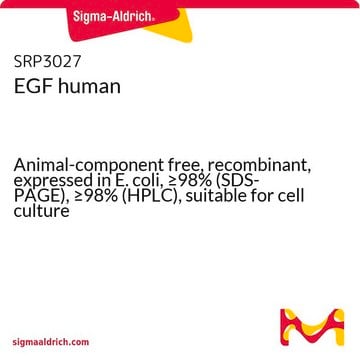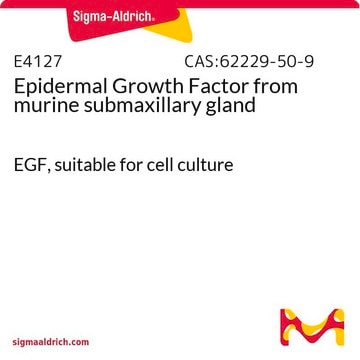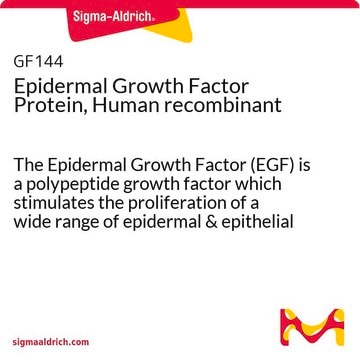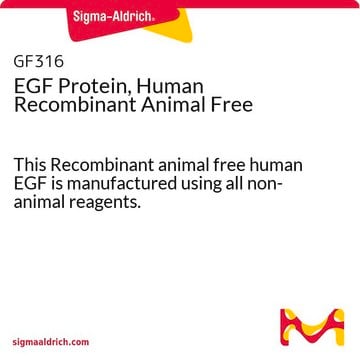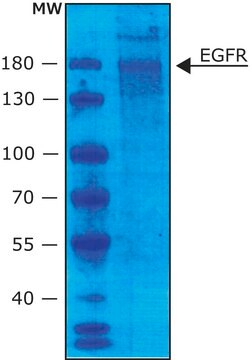E5036
Epidermal Growth Factor, human, animal component free
EGF, recombinant, expressed in Escherichia coli, >97% (SDS-PAGE)
Synonim(y):
Epidermal Growth Factor human, EGF
About This Item
Polecane produkty
pochodzenie biologiczne
human
Poziom jakości
rekombinowane
expressed in E. coli
Próba
>97% (SDS-PAGE)
Postać
lyophilized powder
siła działania
0.08-0.8 ng/mL EC50
masa cząsteczkowa
~6 kDa
opakowanie
pkg of 200 and 500 μg
warunki przechowywania
avoid repeated freeze/thaw cycles
zanieczyszczenia
≤1 EU/μg Endotoxin
kolor
white
rozpuszczalność
water: soluble 0.190-0.210, clear, colorless
numer dostępu UniProt
temp. przechowywania
−20°C
informacje o genach
human ... EGF(1950)
Szukasz podobnych produktów? Odwiedź Przewodnik dotyczący porównywania produktów
Powiązane kategorie
Opis ogólny
Zastosowanie
- as a supplement in in LHC-8 medium to culture liver cell lines
- in the fetal bovine serum (FBS)-Dulbecco′s modified essential medium (DMEM) /F12 medium for primary culture of human glioma cells
- as an additive in the conditional medium of normal fibroblasts (NFs) to study its effect on the migration and invasion of endometrial cancer (EC) cells
- as a component in tumorsphere medium
Działania biochem./fizjol.
Cytowanie
2. Gregory, H., Isolation and structure of urogastrone and its relationship to epidermal growth factor. Nature, 257, 325-327 (1975).
3. George-Nascimento, C. et al., Characterization of recombinant human epidermal growth factor produced in yeast. Biochemistry, 27, 797-802 (1988).
4. Todaro, G.J. et al., Transforming growth factors produced by certain human tumor cells: polypeptides that interact with epidermal growth factor receptors. Proc. Natl. Acad. Sci. USA, 77, 5258-5262 (1980).
5. Blomquist, M.C. et al., Vaccinia virus 19-kilodalton protein: relationship to several mammalian proteins, including two growth factors. Proc. Natl. Acad. Sci. USA, 81, 7363-7367 (1984).
6. Eppstein, D.A. et al., Epidermal growth factor receptor occupancy inhibits vaccinia virus infection. Nature, 318, 663-665 (1985).
Kod klasy składowania
13 - Non Combustible Solids
Klasa zagrożenia wodnego (WGK)
WGK 2
Temperatura zapłonu (°F)
Not applicable
Temperatura zapłonu (°C)
Not applicable
Certyfikaty analizy (CoA)
Poszukaj Certyfikaty analizy (CoA), wpisując numer partii/serii produktów. Numery serii i partii można znaleźć na etykiecie produktu po słowach „seria” lub „partia”.
Masz już ten produkt?
Dokumenty związane z niedawno zakupionymi produktami zostały zamieszczone w Bibliotece dokumentów.
Klienci oglądali również te produkty
Produkty
Discover answers to your frequently asked questions about animal component-free, xenobiotic-free, and chemically defined media and reagents for cell culture.
Role of growth factors in stem cell differentiation and various growth factors for your research at sigmaaldrich.com
Nasz zespół naukowców ma doświadczenie we wszystkich obszarach badań, w tym w naukach przyrodniczych, materiałoznawstwie, syntezie chemicznej, chromatografii, analityce i wielu innych dziedzinach.
Skontaktuj się z zespołem ds. pomocy technicznej
